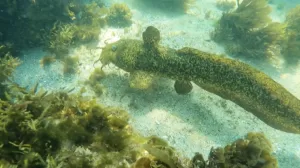The estuary cobbler, also known as Cnidoglanis macrocephalus, is a fascinating species of marine catfish native to the estuarine and coastal waters of southern Australia. Known for its distinctive whisker-like barbels that aid in detecting prey in murky waters, this bottom-dweller is adept at navigating the complex environments of estuaries. The estuary cobbler plays a crucial role in its habitat, contributing to the ecological balance by feeding on detritus and smaller aquatic organisms.
Identification
The estuary cobbler is easily identifiable by its robust, elongated body and the presence of four long, whisker-like barbels around its mouth, which it uses to sense food in turbid waters. Typically coloured a muddy brown to blend seamlessly with the estuarine bottoms, this catfish can reach lengths of up to 60 centimetres. A distinctive feature of the estuary cobbler is its venomous dorsal and pectoral spines, which provide a defense mechanism against predators. The fish’s skin is tough and leathery, lacking scales, which is characteristic of the catfish family. These features not only aid in its survival but also in navigating the complex environments of estuaries and coastal waters where it is commonly found.
Distribution and Conservation
The estuary cobbler is primarily distributed along the southern coasts of Australia, ranging from Western Australia to New South Wales, thriving in estuarine and nearshore environments. It is often spotted at Shelly Beach in Manly. This species is particularly adept at residing in both brackish and marine settings, often found buried in sandy or muddy substrates where rivers meet the sea.
Want to spot new fish species? This book by Nigel March documents 100 diving and snorkeling spots across Australia, and which species might be found there.
Despite its wide distribution, the estuary cobbler faces various threats including habitat degradation, pollution, and the impacts of climate change such as alterations in water temperature and salinity. Conservation efforts are essential to monitor and preserve their populations, involving habitat protection and pollution control to maintain the ecological balance of their native environments. Such measures are crucial to ensuring the survival of this unique species within its natural habitat.
Risk and safety
When encountering the estuary cobbler, it is important to handle the situation with care due to the fish’s venomous spines located on its dorsal and pectoral fins. These spines can deliver a painful sting posing a safety risk to unaware swimmers or fishermen. Symptoms range from severe pain around the envenomated area of the body, to swelling, nausea, perspiration, paralysis of the limbs and fainting. Protective gloves should be worn when handling or attempting to remove these fish from nets or lines to minimise injury.
Awareness and caution are advised when walking in shallow, murky waters where estuary cobblers are likely to be found, to avoid accidental stepping on or disturbing these fish. Prompt medical attention is recommended if stung, to effectively manage symptoms and prevent complications.

Distribution
Temperate marine waters from southern Queensland to southern Western Australia.
Facts
Max Size: 60 cm
Depth: 0-30m
Estimated Lifespan: 20 years
Risk and Safety
Caution is required as their defensive venomous spines can cause painful injuries if disturbed.
Conservation
IUCN Status: Least Concern
Population: Trend Unknown

